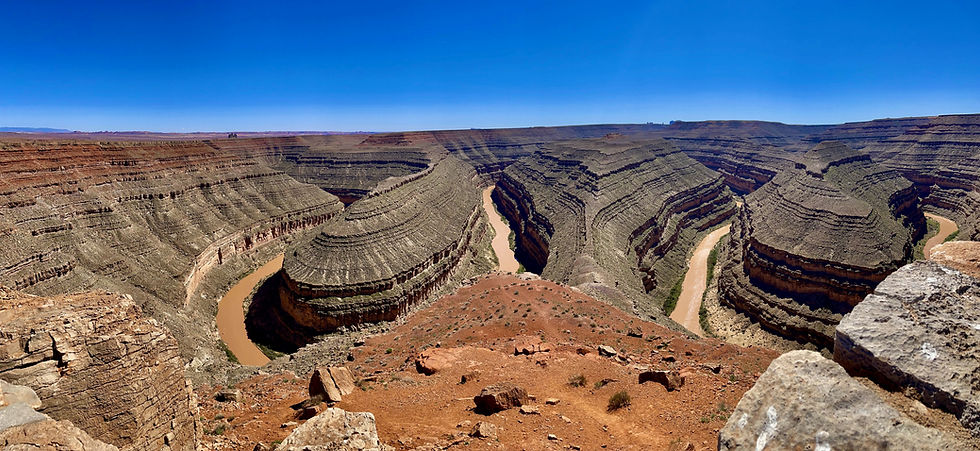Spiral Jetty - Earthwork Art in Utah that Won't Disappear
- Dustin Cook

- Nov 30, 2020
- 4 min read
Updated: Mar 2, 2021

What is the Spiral Jetty you might be asking yourself? The Spiral Jetty is an earthwork sculpture that was created by the American Sculptor Robert Smithson in 1970 on the banks of the Great Salt Lake. The Spiral Jetty is made of mud, salt crystals, basalt rocks and water and forms a 1,500 foot long and 15 foot wide counterclockwise coil beginning at the shore and extending in to the lake. Smithson described his art as "the edge of the sun, a boiling curve, an explosion rising into a fiery prominence."
Getting There
To get to the Spiral Jetty take exit 365 from I-15 toward Corinne. Pass Corinne and head toward Promontory Point and the Golden Spike National Monument. Follow the signs until you get to the National Monument. From the National Monument you will follow a well grated gravel road about another 10 miles to the Spiral Jetty. There are signs that point the way on the gravel road at the different forks in the road, but always take a left toward the Great Salt Lake and you'll be fine. You can also find the Spiral Jetty on Google Maps and GPS your way there. The road ends at the parking lot for the Spiral Jetty.

The Spiral Jetty
The Spiral Jetty is pretty remote and it is unlikely that you will run into more than a handful of people on your trip out to the Jetty. The Spiral Jetty is visible from the parking lot at the end of the road. While you can get a decent view from your car, it is definitely work walking down to take a closer work.
Like most art, you can't truly appreciate it, until you take the time to examine it closely. Shortly after its creation, the Spiral Jetty was submerged for more than 20 years due to high run-off from mountain snows causing the Great Salt Lake levels to rise. Finally in 1993 the Spiral Jetty was revealed for three years until it was submerged again in 1996 and remained covered until 2002. Since then the Spiral Jetty has been visible above the lake's surface for the most part.

The last time the Spiral Jetty was partially submerged was after the heavy runoff from the winter of 2011. During my trip out there I was able to walk right up to the Spiral Jetty and inspect it up close. The lake was actually much farther out, and a couple of the parties who came to see the Spiral Jetty walked probably another 1/3 of a mile out to the Lake itself.
The original design and intention of the artwork was to have the Spiral partially exposed in the pinkish red waters of the Great Salt Lake. The water is pinkish-red in this part of the Great Salt Lake due to the high salinity and concentration of brine in the water. From the air, you can see the waters of the Great Salt Lake are two different colors. This occurred after the building of a causeway across the lake in the late 1950s, dividing the lake in two and causing the salinity of the northern part of the lake to increase turning it slightly pink.

The black basalt rocks in the raised bed of sand and mud creates a beautiful contrast with the salty barren lake bed of the Great Salt Lake. Many walk along the Spiral and trace it to its center. It is a place where you could spend an hour or two admiring the Spiral and walking out to the lake and even bring a picnic to eat in the parking lot. Note however that there are no restroom facilities at Rozel Point.
Golden Spike National Monument

If you are going to make the trip out to the Spiral Jetty you might as well stop into the Golden Spike monument as well. You'll drive right past it on your way out and back from the Spiral Jetty, and it is a great opportunity to get a little history. It marks the spot where the Union Pacific and Central Pacific railroads met and drove the last spike into what would be the United State's first transcontinental railroad.

The center itself is likely just a short stop with a few exhibits, a film and then visiting the spot where the Golden Spike ceremony was held on May 10th 1869. There is an auto tour east on your way back to the freeway which follows where the original track was laid. On the auto tour check out Chinese Arch, which is small natural arch set against the background of the Salt Lake Valley. It was definitely worth the short drive.
I hope this blog post was helpful and as with all posts if you have any questions, comments or feedback feel free to leave them in the comments section below. If you found this article helpful and are planning other adventures in Utah consider signing up for our e-mail list (simply go to the top of page and click subscribe - it's free!) to get the latest adventure posts. You can also sign up to be a member here to share comments at the bottom of our posts and in our forums. Most importantly don't forget to get outside and find your adventure!






Comments